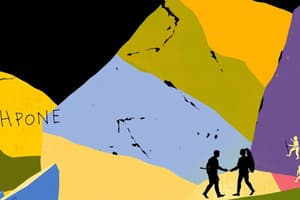Podcast
Questions and Answers
What led to stronger tools and advanced weaponry during the Iron Age?
What led to stronger tools and advanced weaponry during the Iron Age?
- The adoption of iron tools and weapons (correct)
- The introduction of bronze tools
- The use of stone tools
- The reliance on fire for survival
What was Dmitri Mendeleev's primary method of organizing the elements?
What was Dmitri Mendeleev's primary method of organizing the elements?
- By electron configuration
- By increasing atomic mass (correct)
- By decreasing atomic mass
- By density and properties
Which of the following statements correctly describes electrons?
Which of the following statements correctly describes electrons?
- They are positively charged particles within the nucleus
- They have no charge and are located in the nucleus
- They are negatively charged particles orbiting the nucleus (correct)
- They are larger particles made up of protons and neutrons
Where on the periodic table are non-metals primarily located?
Where on the periodic table are non-metals primarily located?
What do neutrons represent in an atom?
What do neutrons represent in an atom?
Flashcards
What are protons?
What are protons?
The positively charged particles found in the nucleus of an atom.
What is the atomic number?
What is the atomic number?
The number of protons in an atom's nucleus, determining its element.
What are periods on the periodic table?
What are periods on the periodic table?
The horizontal rows on the periodic table, elements in the same period share electron shell levels.
What are groups on the periodic table?
What are groups on the periodic table?
Signup and view all the flashcards
What is the nuclear model of the atom?
What is the nuclear model of the atom?
Signup and view all the flashcards
Study Notes
Stone Age, Bronze Age, and Iron Age
- Stone Age: Humans used stone tools for hunting, gathering, and building. They relied on fire and tools for survival.
- Bronze Age: Humans used bronze for tools and weapons, leading to improvements in various areas.
- Iron Age: Iron tools and weapons became common, resulting in stronger tools and more advanced weaponry.
Atomic Models and Subatomic Particles
- John Dalton proposed the Solid Sphere Model, where atoms are indivisible spheres.
- J.J. Thomson proposed the Plum Pudding Model, introducing subatomic particles, electrons.
- Ernest Rutherford's gold foil experiment led to the Nuclear Model, featuring a nucleus.
Electrons, Protons, and Neutrons
- Electrons: Negatively charged particles orbiting the nucleus.
- Protons: Positively charged particles located in the nucleus.
- Neutrons: Particles with no charge, also part of the nucleus.
Atomic Mass
- Atomic mass: The total mass of an atom, primarily determined by the mass of protons and neutrons.
Dmitri Mendeleev and the Periodic Table
- Dmitri Mendeleev organized elements by increasing atomic mass.
- He predicted properties of undiscovered elements.
20 Elements (Examples)
- Hydrogen (H), Helium (He), Lithium (Li), Beryllium (Be), Boron (B), Carbon (C), Nitrogen (N), Oxygen (O), Fluorine (F), Neon (Ne), Sodium (Na), Magnesium (Mg), Aluminum (Al), Silicon (Si), Phosphorus (P), Sulfur (S), Chlorine (Cl), Argon (Ar), Potassium (K), and Calcium (Ca).
Periodic Table (PT) Information
- Atomic Mass: Located below the element symbol on the PT.
- Atomic Number: Located above the element symbol on the PT.
- Periods: Horizontal rows on the PT.
- Groups: Vertical columns on the PT.
- Metals: Located on the left and center of the PT.
- Non-Metals: Located on the right side of the PT (excluding hydrogen).
- Metalloids: Located along the "stair-step" line between metals and nonmetals.
- Noble Gases: Located in Group 18 (far right column) of the PT.
Determining Protons, Electrons, and Neutrons
- Protons: Equal to the atomic number.
- Electrons: Equal to the number of protons.
- Neutrons: Calculated by subtracting the atomic number from the atomic mass.
Observations and Theories
- Scientists made numerous observations and developed theories because they continually sought to improve previous theories and discoveries through experimentation and further observations.
Studying That Suits You
Use AI to generate personalized quizzes and flashcards to suit your learning preferences.




